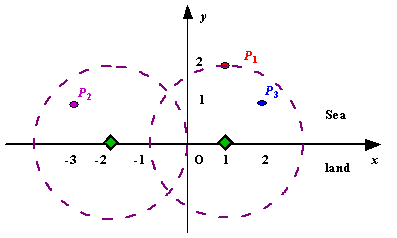Description
Assume the coasting is an infinite straight line. Land is in one side of coasting, sea in the other. Each small island is a point locating in the sea side. And any radar installation, locating on the coasting, can only cover d distance, so an island in the sea can be covered by a radius installation, if the distance between them is at most d.
We use Cartesian coordinate system, defining the coasting is the x-axis. The sea side is above x-axis, and the land side below. Given the position of each island in the sea, and given the distance of the coverage of the radar installation, your task is to write a program to find the minimal number of radar installations to cover all the islands. Note that the position of an island is represented by its x-y coordinates.

Figure A Sample Input of Radar Installations
Input
The input consists of several test cases. The first line of each case contains two integers n (1<=n<=1000) and d, where n is the number of islands in the sea and d is the distance of coverage of the radar installation. This is followed by n lines each containing two integers representing the coordinate of the position of each island. Then a blank line follows to separate the cases.
The input is terminated by a line containing pair of zeros
Output
For each test case output one line consisting of the test case number followed by the minimal number of radar installations needed. "-1" installation means no solution for that case.
Sample Input
3 2 1 2 -3 1 2 1 1 2 0 2 0 0
Sample Output
Case 1: 2 Case 2: 1
分析:
简单的贪心,先按x轴排序,记录圆心位置范围,如果一个点的圆心范围和前面一个圆心范围有交集,就把前一个圆心范围更新为他们的交集
不然答案+1,将当前圆心范围记录下来,最后输出ans
#include <iostream> #include <algorithm> #include <cstdio> #include <cmath> using namespace std; struct node { int x, y; }; node g[1111]; double posr[1111], posl[1111]; int n, d, ans; int cmp (node a, node b) { if (a.x == b.x) return a.y > b.y; return a.x < b.x; } double fx (node x) { double k = sqrt (1.*d * d - x.y * x.y); return k; } int main() { for (int t = 1; cin >> n >> d; t++) { if (n == 0 && d == 0) break; ans = 0; for (int i = 1; i <= n; i++) { cin >> g[i].x >> g[i].y; if (g[i].y > d) ans = -1; } if (ans == 0) { sort (g + 1, g + 1 + n, cmp); if (n >= 1) { posl[++ans] = g[1].x - fx (g[1]); posr[ans] = g[1].x + fx (g[1]); } for (int i = 2; i <= n; i++) { if (g[i].x == g[i - 1].x) continue; if (g[i].x - fx (g[i]) > posr[ans]) { posl[++ans] = g[i].x - fx (g[i]), posr[ans] = g[i].x + fx (g[i]); continue; } posl[ans] = max (posl[ans], g[i].x - fx (g[i]) ), posr[ans] = min (posr[ans], g[i].x + fx (g[i]) ); } } printf ("Case %d: %d ", t, ans); } return 0; }
http://www.cnblogs.com/keam37/ keam所有 转载请注明出处